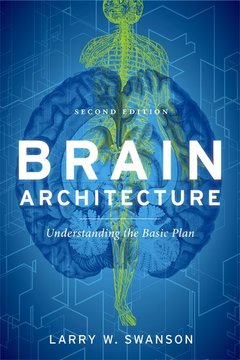Description
Brain Architecture (2nd Ed.)
Understanding the Basic Plan
Author: Swanson Larry W.
Language: English
Subject for Brain Architecture:
Approximative price 72.62 €
In Print (Delivery period: 21 days).
Add to cart
Publication date: 10-2011
352 p. · 14.1x21 cm · Paperback
352 p. · 14.1x21 cm · Paperback
Description
/li>Contents
/li>Biography
/li>
Now in its second edition, Brain Architecture is the continued exploration of how the brain works. At the very core of our existence, the brain generates our thoughts and feelings, directs our voluntary interactions with the environment, and coordinates all of the vital functions within the body itself. This long-overdue new edition explains this oftentimes daunting intricacy and exquisite detail. The first half of the book discusses the basic parts and how they work, presenting an overview of the nervous system at both the microscopic and macroscopic levels. The approach follows three classic lines of thought that proceed from simple to complex: the history of neuroscience research, the evolution of the nervous system, and the embryological development of the vertebrate central and peripheral nervous systems. The second half of the book outlines the basic wiring diagram of the brain and nervous system-how the parts are interconnected and how they control behavior and the internal state of the body. This is done within the framework of a new four-system network model that greatly simplifies understanding the structure-function organization of the nervous system. Written in clear and sparkling prose, beautifully illustrated, and thoroughly updated, Brain Architecture, Second Edition is must-read for anyone interested in the science of how the brain works.
Preface to First Edition. 1. Thinking about the Brain: Body and Mind. 2. How the Brain Works: History, Structure and Function. 3. The Simplest Nervous Systems: Neurons, Nerve Nets, and Behavior. 4. Centralization and Symmetry: Ganglia and Nerves. 5. The Basic Vertebrate Plan: Transverse Divisions. 6. Neurogenesis: Longitudinal Divisions, Parts List, and Adult Flatmap. 7. Brain and Behavior: A Four Systems Network Model. 8. The Motor System: Coordinating External and Internal Behaviors. 9. The Behavioral State System: Intrinsic Control of Sleep and Wakefulness. 10. The Cognitive System: Thinking and Voluntary Control of Behavior. 11. The Sensory System: Inputs from Environment and Body. 12. Modifiability: Learning, Stress, Cycles, and Damage Repair. 13. Genome and Connectome.
Larry W. Swanson, PhD, is Milo Don and Lucille Appleman Professor of Biological Sciences at the University of Southern California in Los Angeles, CA. Dr. Swanson has published over 250 research articles and numerous books on brain organization, and is a member of National Academy of Sciences, American Academy of Arts and Sciences, and the Grolier Club.
© 2024 LAVOISIER S.A.S.




